3.2
Impact Factor
ISSN: 1837-9664
J Cancer 2012; 3:49-57. doi:10.7150/jca.3621 This volume Cite
Research Paper
A Meta-Analysis of the Short- And Long-Term Results of Randomized Controlled Trials That Compared Laparoscopy-Assisted and Open Colectomy for Colon Cancer
1. Department of Surgery, Osaka City Sumiyoshi Hospital
2. Department of Surgery, Osaka City General Hospital
3. Department of Surgical Oncology, Osaka City University Graduate School of Medicine
Received 2011-10-11; Accepted 2012-1-10; Published 2012-1-13
Abstract
Purpose: We conducted a meta-analysis to evaluate and compare the short- and long-term results of laparoscopy-assisted colectomy (LAC) and open colectomy (OC) for colon cancer.
Methods: We searched MEDLINE, EMBASE, Science Citation Index, and Cochrane Controlled Trial Register for relevant papers published between January 1990 and October 2011 by using the search terms “laparoscopy,” “laparoscopy-assisted,” “surgery,” “colectomy,” “colon cancer,” and “randomized clinical trials (RCTs)”. We analyzed the outcomes of each type of surgery over short- and long-term periods.
Results: We selected 12 papers reporting RCTs that compared LAC with OC for colon cancer. Our meta-analysis included 4614 patients with colon cancer; of these, 2444 had undergone LAC and 2170 had undergone OC. In the short-term period, we found that the rates of overall postoperative complications and ileus in LAC were lower than in OC groups. LAC was associated with a reduction in intraoperative blood loss, a shorter duration of time to resumption and hospital stay, and lower rates of overall complication and ileus over the short-term, but with similar long-term oncologic outcomes such as overall and cancer-related mortality, overall recurrence, local recurrence, distant metastasis, and wound-site recurrence, compared to OC.
Conclusions: It is suggested that LAC may be preferred to OC for colon cancer.
Keywords: meta-analysis, laparoscopy-assisted colectomy, colon cancer
Introduction
Colon cancer is one of the most common types of cancer in developed countries, and surgery is the only curative treatment. Successful laparoscopy-assisted sigmoidectomy for colon cancer was first described in 19911 and has since then been widely applied by surgeons to treat patients with colon cancer.
Several articles have reported the short-term advantages of laparoscopy-assisted colectomy (LAC) over conventional open colectomy (OC) and have concluded that laparoscopic surgery causes less pain, results in better pulmonary function, shortens the duration of postoperative ileus, reduces fatigue, and offers a better quality of life2-5. However, the benefits of LAC have remained controversial because the long-term outcomes have not yet been clarified. To accurately evaluate the efficacy of laparoscopic surgery for colon cancer, the short- and long-term outcomes of laparoscopic surgery must be compared to those of open surgery. For short-term outcomes, perioperative variables, pathologic factors, and the cost of surgery should be examined. For long-term outcomes, long-term oncologic results are the primary endpoint of interest. The long-term oncologic outcomes of LAC, such as tumor recurrence rate and mortality rate, have been published over time6-9. Several randomized control trials (RCTs) that compare LAC with OC have been reported 6-25. Therefore, we conducted a meta-analysis of the data obtained from these RCTs and compared the short- and long-term outcomes of LAC and OC by considering several factors.
Materials and methods
Literature search
To identify papers relevant to our study, we searched through the major medical databases such as MEDLINE, EMBASE, Science Citation Index, and Cochrane Controlled Trial Register for studies published between January 1990 and October 2011. The following search terms were used: “laparoscopy,” “laparoscopy-assisted,” “surgery,” “colectomy,” and “colon cancer.” Furthermore, we limited our literature search to randomized controlled trials. We treated studies that were part of a series as a single study. The appropriate data from such study series were used for this meta-analysis. This meta-analysis was prepared in accordance with the Preferred Reporting Items for Systematic Reviews and Meta-Analyses (PRISMA) statement26 (Fig.1).
Inclusion criteria
To enter this meta-analysis, studies had to: (1) be described in English (2) be randomized controlled trials (3) compare laparoscopic and open conventional surgery for colon cancer (4) report on at least one of the outcome measures mentioned below.
Flow diagram of this meta-analysis in accordance with PRISMA Statement.
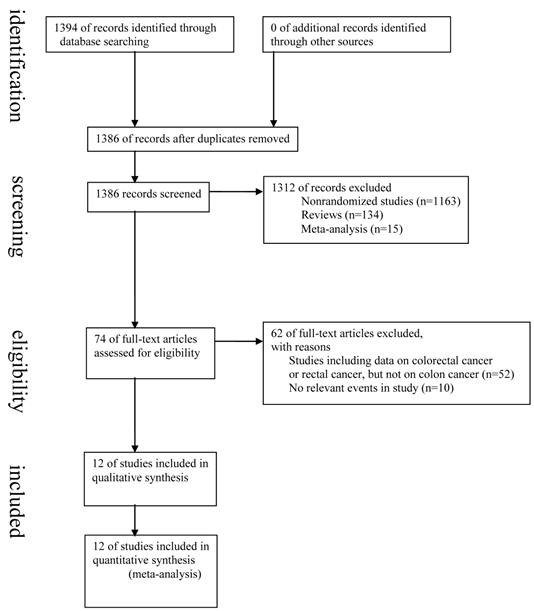
Data extraction
Three researchers (H.O., Y.T., and Y.A.) extracted data from each article by using a structured sheet and entered the data into a database. Because this analysis was based on the intention-to-treat principle27, all patients converted from the laparoscopic group to the conventional open surgery group remained in the laparoscopic group for analysis. We conducted separate meta-analyses for 2 different postoperative time periods: short-term and long-term. For the short-term analysis, we collected data on operation time, estimated blood loss, number of transfused patients, number of dissected lymph nodes, time to resumption, hospital stay, incision length, overall postoperative complications, ileus, anastomotic leakage, perioperative mortality, circumferential resection margin, oral resection margin, distal resection margin, and cost of surgery. We also examined the relationship between the conversion rate from laparoscopic to open surgery and single-institution versus multicenter trials. For the oncologic results in the long-term analysis, we used data on the rate of overall recurrence, local recurrence, distant metastasis, peritoneal dissemination, wound-site recurrence, overall mortality, and cancer-related mortality. If necessary, we contacted the authors of the original article to collect further information.
Assessment of study quality
The quality of the randomized controlled trials was assessed using Jadad's scoring system28. Two reviewers (H.O., Y.T.) assessed all studies that met the inclusion criteria (Table 1).
Statistical analysis
Weighted mean differences (WMDs) and odds ratios (ORs) were used for the analysis of continuous and dichotomous variables, respectively. Random-effects models were used to identify heterogeneity between the studies29, and the degree of heterogeneity was assessed using the χ2 test. For the analysis of the conversion rate, the χ2 test was used. The confidence interval (CI) was established at 95%, and p values of less than 0.05 were considered to indicate statistical significance.
Characteristics of randomized controlled trials.
| authors | Year | country | number of reference | institutions of the study | Conversion rate (%) | Study size (n) | follow-up period (months) | Randomization | Double Blinding | Withdrawals and dropouts | Jadad's score | |
|---|---|---|---|---|---|---|---|---|---|---|---|---|
| LC | OC | |||||||||||
| Braga et al. | 2010 | Italy | 10 | single center | 5.2(7/134) | 134 | 134 | 73 months (median) | 2 | 2 | 1 | 5 |
| CLASICC trial | 2010, 2007, 2005 | UK | 6, 7, 13, 21 | multicenter (27) | 25(61/246) | 526 | 268 | 56.3 months (median) | 2 | 2 | 1 | 5 |
| COLOR trial | 2009, 2005 | Sweden, Netherlands, Spain, Italy, France, UK, Germany | 14, 15 | multicenter (29) | 19(102/534) | 534 | 542 | 53 months (median) | 2 | 2 | 1 | 5 |
| COST trial | 2004 | USA and Canada | 16, 18 | multicenter (48) | 21(90/435) | 435 | 428 | 7 years (median) | 2 | 2 | 1 | 5 |
| Curet et al. | 2000 | USA | 17 | single center | 28(7/25) | 25 | 18 | 4.9 years (mean) | 2 | 2 | 1 | 5 |
| ALCCaS trial (Hewett et al.) | 2008 | Australia and New Zealand | 24 | multicenter (31) | 14.6(43/294) | 294 | 298 | unknown | 2 | 0 | 1 | 3 |
| Kaiser et al. | 2004 | USA | 22 | single center | 46.4(13/28) | 28 | 20 | 35 months (median) | 2 | 0 | 1 | 3 |
| Barcelona trial (Lacy et al.) | 2008 | Spain | 8, 9 | single center | 11(12/111) | 111 | 108 | 95 months (median) | 2 | 2 | 1 | 5 |
| Liang at al. | 2006 | Taiwan | 19 | single center | 3(4/135) | 135 | 134 | 40 months (median) | 2 | 2 | 1 | 5 |
| Mirza et al. | 2008 | UK | 20 | single center | 17 (19/113) concluding rectal cancer | 116 | 117 | 48 months (median) | 1 | 0 | 0 | 1 |
| Pascual et al. | 2011 | Spain | 23 | single center | 12(7/60) | 60 | 60 | 41 months (median) | 2 | 2 | 1 | 5 |
| Winslow et al | 2002 | USA | 25 | single center | 15(7/46) | 46 | 43 | 30.1 months (mean) | 2 | 0 | 1 | 3 |
UK: United Kingdom, US: United States of America
As the cost data of 1 article21 were precious and had neither a range nor any other measure of dispersion, the standard deviation (SD) was estimated by halving the mean30. One Euro and British pound were converted to 1.4 and 1.6 US dollars, respectively. Statistical analyses were performed using the Review Manager (RevMan) software version 5.1.4 provided by the Cochrane Collaboration, Copenhagen, Denmark.
Results
We identified 12 RCTs that compared LAC and OC for colon cancer6-25. The characteristics of each RCT are presented in Table 1. Our meta-analysis included 4614 patients with colon cancer; of these, 2444 had undergone LAC, and 2170, OC. The results of the outcomes over short- and long-term periods are shown in Fig. 2 and Fig. 3, respectively.
Meta-analysis of the short-term period for colon cancer
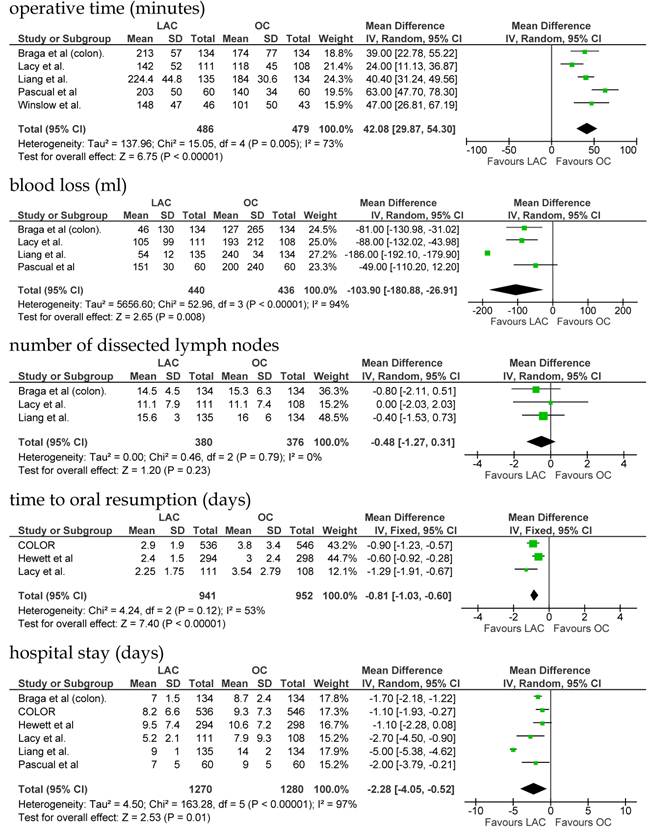
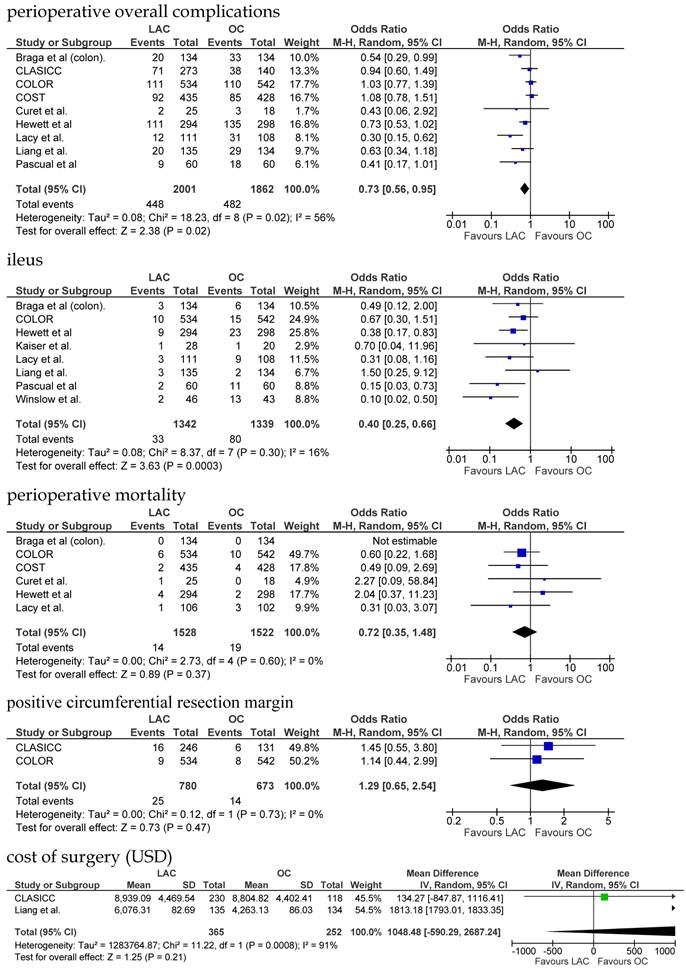
Meta-analysis of the long- term oncologic results for colon cancer
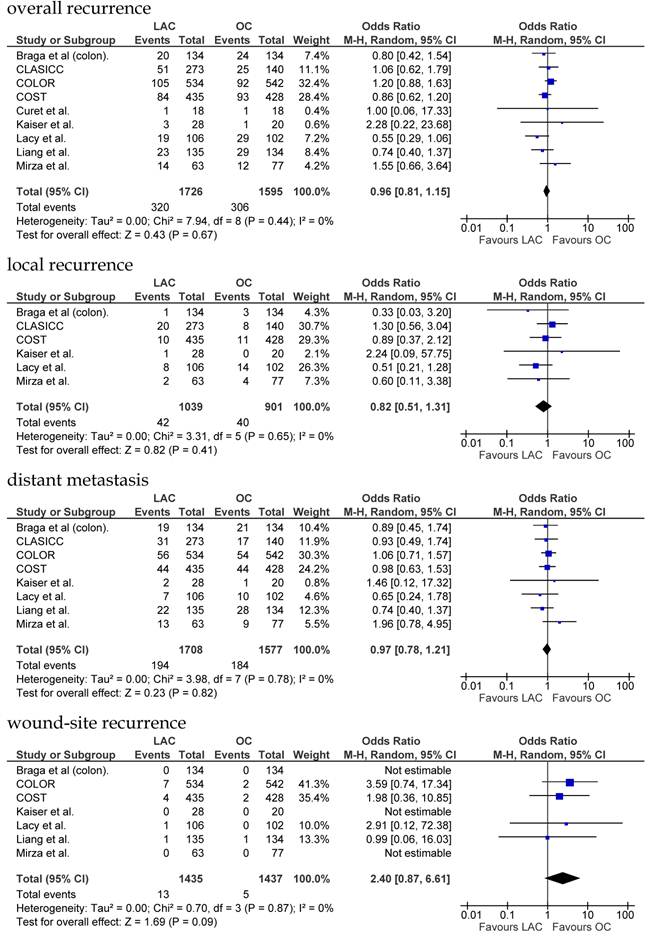
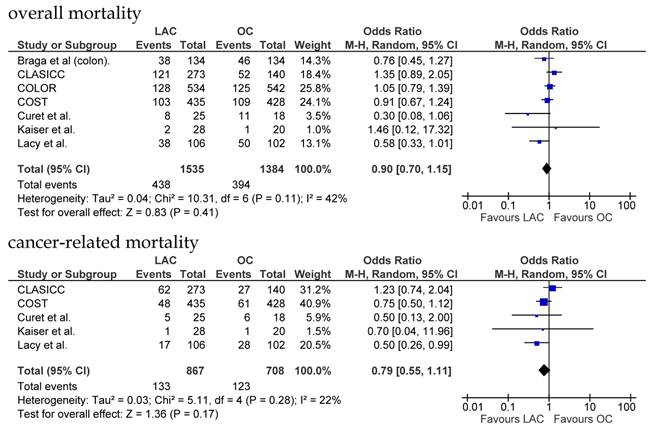
Short-term outcomes
Of the 12 RCTs, 5 reported the operative duration; in all 5 reports, the operative duration was significantly longer for LAC than for OC. Our analysis showed that the operative duration for LAC was significantly longer than that for OC by 42.08 min (WMD = 42.08; 95% CI = 29.87 to 54.30; p < 0.00001). Blood loss in patients who underwent LAC was significantly lesser than that in patients who underwent OC, by an average volume of 103.9 ml (WMD = -103.90; 95% CI = -180.88 to -26.91; p = 0.008). There was no significant difference in the number of transfused patients. We found no significant difference in the number of dissected lymph nodes between LAC and OC groups. The duration of hospital stay and the time to oral diet were significantly shorter with LAC than with OC (p = 0.01 and < 0.00001, respectively). The incision length was significantly shorter by 11.77 cm in LAC than in OC. The rate of the overall postoperative complications was significantly lower in LAC than in OC (OR = 0.73; 95% CI =0.56 to 0.95; p = 0.02). In examining the details of them, we found that the rate of ileus was significantly lower in LAC than in OC (OR = 0.40; 95% CI =0.25 to 0.66; p = 0.0003). The rate of anastomotic leakage between the 2 groups was insignificant. We also found no significant differences in perioperative mortality between the 2 groups when we pooled the data for LAC and OC for colon cancer.
Pathological factors
In an analysis of pooled data, we found that there was no significant difference in the circumferential resection margin between the 2 groups. There was no significant difference in the oral and distal resection margin.
Cost of surgery
In an analysis of the total cost of surgery, there was no significant difference between the 2 groups.
Conversion rate
Twelve articles reported data on the conversion rate from laparoscopic to open surgery, which ranged from 3 to 46.4% (Table 1). In an analysis of the conversion rate, there was no significant difference between the trials performed by a single institution and those performed on a multicenter basis (p = 0.31).
Long-term outcomes
With respect to overall recurrence, local recurrence, distant metastasis, and peritoneal dissemination, the differences between the 2 groups were insignificant. Our analysis of the wound-site recurrence between the LAC and OC groups indicated no significant difference. There was also no significant difference in the overall and cancer-related mortality between the 2 groups.
Heterogeneity
In the short-term period, significant heterogeneity was detected between studies for the following 6 factors: operative time, intraoperative blood loss, duration of hospital stay, incision length, overall postoperative complications, and cost of surgery. In the long-term periods, no significant heterogeneity was detected between studies.
Discussion
In short-term periods, laparoscopic surgery for colon cancer is associated with a significantly longer operative time, but significantly less intraoperative blood loss compared with conventional open surgery. These results are consistent with those of recent randomized controlled trials 8,13,15. Potential explanations for the abovementioned results include meticulous dissection facilitated by instruments for laparoscopic surgery and videoscopic magnification. The similarity of oncological outcomes such as circumferential, oral, and distal resection margin and the number of harvested lymph nodes between the 2 groups indicates identical quality of the operative techniques. Patients who underwent LAC resumed oral intake significantly earlier and had significantly shorter hospital stays than did patients who underwent OC; this finding suggests that LAC leads to faster recovery. The rate of postoperative complications was significantly lower in LAC than on OC. In examining the details, we found the rate of ileus significantly lower in LAC than in OC. Gutt et al. describe that laparoscopic surgery reduces adhesion formation compared with open surgery. Because laparoscopic procedures reduce the overall degree of trauma to the abdominal wall, intraabdominal operative site, and distant intraabdominal organs, they potentially have an advantage in reducing the formation of postoperative adhesion31. The abovementioned suggests that LAC may be safer and more feasible than OC.
In the analysis of the total cost of surgery, we found no significant overall difference between LAC and OC. However, the operating costs were higher and the hospitalization costs were lower for LAC compared with OC.
Several reports have shown that conversion from laparoscopic to open surgery is associated with inferior surgical outcomes6. In this analysis, the conversion rate was not significantly related to the type of study, i.e., single-institution or multicenter. The CLASICC trial reported that tumor infiltration/fixation and obesity were the most common reason for conversion13.
In the long-term period, we found no significant difference in overall recurrence, local recurrence, distant metastasis, and peritoneal dissemination between the 2 surgery groups. There was also no significant difference in wound-site recurrence between the 2 groups. No significant difference was found in overall and cancer-related mortality. The abovementioned findings suggest that LAC is comparable to OC with respect to long-term oncologic results. Lacy et al. reported that there was a tendency of higher cancer-related and overall survival for LAC9, but our meta-analysis of the pooled data did not show this difference.
Significant heterogeneity was observed for operative time, intraoperative blood loss, duration of hospital stay, incision length, overall postoperative complications, and cost of surgery in the short-term period. The reason for the observed heterogeneity in operative time, intraoperative blood loss, and overall postoperative complications may be variations in the skill of the surgeon and the condition of the tumor. Differences in the clinical approach at different institutions may have caused the heterogeneity in the duration of hospital stay and incision length. Significant heterogeneity for cost of surgery may be caused by differences in medical fees among countries.
In conclusion, this meta-analysis showed that laparoscopic surgery for colon cancer is associated with a reduction in intraoperative blood loss, earlier resumption of oral intake, shorter duration of hospital stay, and rate of postoperative complications concluding ileus over the short-term, but is associated with similar short-term and long-term oncologic outcomes compared to conventional open surgery. Therefore, it is suggested that laparoscopic surgery may be preferred to conventional open surgery for colon cancer.
Conflict of Interest
The authors have declared that no conflict of interest exists.
References
1. Jacobs M, Verdeja JC, Goldstein HS. Minimally invasive colon resection (laparoscopic colectomy). Surg Laparosc Endosc. 1991;1:144-150
2. Schwenk W, Böhm B, Müller JM. Postoperative pain and fatigue after laparoscopic or conventional colorectal resections. A prospective randomized trial. Surg Endosc. 1998;12:1131-1136
3. Abraham NS, Young JM, Solomon MJ. Meta-analysis of short-term outcomes after laparoscopic resection for colorectal cancer. Br J Surg. 2004;91:1111-1124
4. Braga M, Vignali A, Gianotti L, Zuliani W, Radaelli G, Gruarin P, Dellabona P, Di Carlo V. Laparoscopic versus open colorectal surgery: a randomized trial on short-term outcome. Ann Surg. 2002;236:759-767
5. Weeks JC, Nelson H, Gelber S, Sargent D, Schroeder G; Clinical Outcomes of Surgical Therapy (COST. Study Group. Short-term quality-of-life outcomes following laparoscopic-assisted colectomy vs open colectomy for colon cancer: a randomized trial. JAMA. 2002;287:321-328
6. Jayne DG, Thorpe HC, Copeland J, Quirke P, Brown JM, Guillou PJ. Five-year follow-up of the Medical Research Council CLASICC trial of laparoscopically assisted versus open surgery for colorectal cancer. Br J Surg. 2010;97:1638-1645
7. Jayne DG, Guillou PJ, Thorpe H, Quirke P, Copeland J, Smith AM, Heath RM, Brown JM; UK MRC CLASICC Trial Group. Randomized trial of laparoscopic-assisted resection of colorectal carcinoma: 3-year results of the UK MRC CLASICC Trial Group. J Clin Oncol. 2007;25:3061-3068
8. Lacy AM, García-Valdecasas JC, Delgado S, Castells A, Taurá P, Piqué JM, Visa J. Laparoscopy-assisted colectomy versus open colectomy for treatment of non-metastatic colon cancer: a randomised trial. Lancet. 2002;359:2224-2229
9. Lacy AM, Delgado S, Castells A, Prins HA, Arroyo V, Ibarzabal A, Pique JM. The long-term results of a randomized clinical trial of laparoscopy-assisted versus open surgery for colon cancer. Ann Surg. 2008;248:1-7
10. Braga M, Frasson M, Zuliani W, Vignali A, Pecorelli N, Di Carlo V. Randomized clinical trial of laparoscopic versus open left colonic resection. Br J Surg. 2010;97:1180-1186
11. Braga M, Vignali A, Zuliani W, Frasson M, Di Serio C, Di Carlo V. Laparoscopic versus open colorectal surgery: cost-benefit analysis in a single-center randomized trial. Ann Surg. 2005;242:890-896
12. Braga M, Frasson M, Vignali A, Zuliani W, Civelli V, Di Carlo V. Laparoscopic vs. open colectomy in cancer patients: long-term complications, quality of life, and survival. Dis Colon Rectum. 2005;48:2217-2223
13. Guillou PJ, Quirke P, Thorpe H, Walker J, Jayne DG, Smith AM, Heath RM, Brown JM; MRC CLASICC trial group. Short-term endpoints of conventional versus laparoscopic-assisted surgery in patients with colorectal cancer (MRC CLASICC trial): multicentre, randomised controlled trial. Lancet. 2005;365:1718-1726
14. Colon Cancer Laparoscopic or Open Resection Study Group, Buunen M, Veldkamp R, Hop WC, Kuhry E, Jeekel J, Haglind E, Påhlman L, Cuesta MA, Msika S, Morino M, Lacy A, Bonjer HJ. Survival after laparoscopic surgery versus open surgery for colon cancer: long-term outcome of a randomised clinical trial. Lancet Oncol. 2009;10:44-52
15. Veldkamp R, Kuhry E, Hop WC, Jeekel J, Kazemier G, Bonjer HJ, Haglind E, Påhlman L, Cuesta MA, Msika S, Morino M, Lacy AM; COlon cancer Laparoscopic or Open Resection Study Group (COLOR). Laparoscopic surgery versus open surgery for colon cancer: short-term outcomes of a randomised trial. Lancet Oncol. 2005;6:477-484
16. Clinical Outcomes of Surgical Therapy Study Group. A comparison of laparoscopically assisted and open colectomy for colon cancer. N Engl J Med. 2004May13;350:2050-2059
17. Curet MJ, Putrakul K, Pitcher DE, Josloff RK, Zucker KA. Laparoscopically assisted colon resection for colon carcinoma: perioperative results and long-term outcome. Surg Endosc. 2000;14:1062-1066
18. Fleshman J, Sargent DJ, Green E, Anvari M, Stryker SJ, Beart RW Jr, Hellinger M, Flanagan R Jr, Peters W, Nelson H; for The Clinical Outcomes of Surgical Therapy Study Group. Laparoscopic colectomy for cancer is not inferior to open surgery based on 5-year data from the COST Study Group trial. Ann Surg. 2007;246:655-664
19. Liang JT, Huang KC, Lai HS, Lee PH, Jeng YM. Oncologic results of laparoscopic versus conventional open surgery for stage II or III left-sided colon cancers: a randomized controlled trial. Ann Surg Oncol. 2007;14:109-117
20. Mirza MS, Longman RJ, Farrokhyar F, Sheffield JP, Kennedy RH. Long-term outcomes for laparoscopic versus open resection of nonmetastatic colorectal cancer. J Laparoendosc Adv Surg Tech A. 2008;18:679-685
21. Franks PJ, Bosanquet N, Thorpe H, Brown JM, Copeland J, Smith AM, Quirke P, Guillou PJ; CLASICC trial participants. Short-term costs of conventional vs laparoscopic assisted surgery in patients with colorectal cancer (MRC CLASICC trial). Br J Cancer. 2006;95:6-12
22. Kaiser AM, Kang JC, Chan LS, Vukasin P, Beart RW Jr. Laparoscopic-assisted vs. open colectomy for colon cancer: a prospective randomized trial. J Laparoendosc Adv Surg Tech A. 2004;14:329-334
23. Pascual M, Alonso S, Parés D, Courtier R, Gil MJ, Grande L, Pera M. Randomized clinical trial comparing inflammatory and angiogenic response after open versus laparoscopic curative resection for colonic cancer. Br J Surg. 2011;98:50-59
24. Hewett PJ, Allardyce RA, Bagshaw PF, Frampton CM, Frizelle FA, Rieger NA, Smith JS, Solomon MJ, Stephens JH, Stevenson AR. Short-term outcomes of the Australasian randomized clinical study comparing laparoscopic and conventional open surgical treatments for colon cancer: the ALCCaS trial. Ann Surg. 2008;248:728-738
25. Winslow ER, Fleshman JW, Birnbaum EH, Brunt LM. Wound complications of laparoscopic vs open colectomy. Surg Endosc. 2002;16:1420-1425
26. Moher D, Liberati A, Tetzlaff J, Altman DG, The PRISMA Group. Preferred Reporting Items for Systematic Reviews and Meta-Analyses: The PRISMA Statement. Open Med. 2009;3:123-130
27. Kuhry E, Schwenk WF, Gaupset R, Romild U, Bonjer HJ. Long-term results of laparoscopic colorectal cancer resection. Cochrane Database Syst Rev. 2008Apr16(2):CD003432
28. Jadad AR, Moore RA, Carroll D, Jenkinson C, Reynolds DJ, Gavaghan DJ, McQuay HJ. Assessing the quality of reports of randomized clinical trials: is blinding necessary? Control Clin Trials. 1996;17:1-12
29. DerSimonian R, Laird N. Meta-analysis in clinical trials. Control Clin Trials. 1986;7:177-188
30. Ohtani H, Tamamori Y, Azuma T, Mori Y, Nishiguchi Y, Maeda K, Hirakawa K. A meta-analysis of the short- and long-term results of randomized controlled trials that compared laparoscopy-assisted and conventional open surgery for rectal cancer. J Gastrointest Surg. 2011;15:1375-1385
31. Gutt CN, Oniu T, Schemmer P, Mehrabi A, Büchler MW. Fewer adhesions induced by laparoscopic surgery? Surg Endosc. 2004;18:898-906
Author contact
![]() Corresponding author: Hiroshi Ohtani, Department of Surgery, Osaka City Sumiyoshi Hospital, 1-2-16, Higashi-Kagaya, Suminoe-ku, Osaka 559-0012, Japan. Tel: +81-6-6681-1000. FAX: +81-6-6686-1547. E-mail: m5051923med.osaka-cu.ac.jp
Corresponding author: Hiroshi Ohtani, Department of Surgery, Osaka City Sumiyoshi Hospital, 1-2-16, Higashi-Kagaya, Suminoe-ku, Osaka 559-0012, Japan. Tel: +81-6-6681-1000. FAX: +81-6-6686-1547. E-mail: m5051923med.osaka-cu.ac.jp

 Global reach, higher impact
Global reach, higher impact